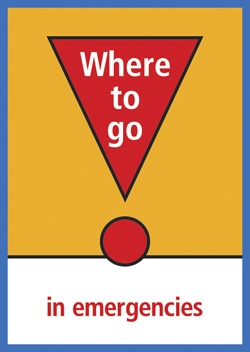Washington University in St. Louis will launch its “Where to Go” campaign this fall to help the campus prepare for emergency situations.
During the fall semester, members of the University’s Crisis Management Team will give presentations at student, staff and faculty meetings explaining where to go for information before, during and after an emergency.

The presentation, which will include a short video, outlines the University’s crisis communications plan and shows how the University’s emergency Web site, emergency.wustl.edu, provides useful information to help the campus community prepare for an emergency.
“During any crisis, the University community must be prepared to respond quickly and appropriately, and we hope that the ‘Where to Go’ campaign will inform the community how to prepare for emergencies and where to go for information in an emergency,” said Steven P. Hoffner, assistant vice chancellor for operations and chair of the Crisis Management Team, a committee appointed by Chancellor Mark S. Wrighton to ensure the University is prepared to cope with a variety of emergencies.
“The University has a plan to protect the campus community in an emergency, but the education and cooperation of students, faculty and staff is crucial to its success,” Hoffner said.
Where to go for information before an emergency
The emergency Web site — emergency.wustl.edu — is the primary source of University information before and during a crisis, said Mark Bagby, University disaster coordinator. The Web site contains information about what to do in particular emergency situations, such as an earthquake, fire or violence on campus. It also features links that faculty, staff, students, parents and others can follow to provide the University with contact information so they can be alerted quickly in a crisis.
“It is crucial that all in the University community review information about what to do in a particular crisis before a crisis occurs,” Bagby said.
In addition, representatives from departments across campus will hold meetings detailing where to go in the building if a particular crisis — such as a tornado, earthquake or chemical spill — occurs.
“As each crisis is different, there are different ways to best handle each emergency,” Bagby said. “The way to respond to a fire — getting out of the building — is not the best course of action in a tornado. That’s why it’s important for everyone in the WUSTL community to familiarize themselves with the emergency instructions at emergency.wustl.edu and attend their department’s emergency planning meetings.”
Where to go for information during an emergency
If a crisis does occur, emergency.wustl.edu will be regularly updated with the most recent information about the emergency and with instructions. If there is no current emergency, the site will say so.
The University may employ many other means of communication in an emergency, including sirens, text messages, e-mails, phone calls and an emergency hotline.
The University is in the process of instituting an Emergency Notification System, which sends emergency messages via text message, phone calls and e-mails to WUSTL e-mail accounts. It is vital that members of the WUSTL community visit emergency.wustl.edu to provide cell phone numbers and update their personal contact information so the University can reach all members in a crisis. Contact information can be updated by following the links at the emergency Web site.
“Text messaging has proved to be an effective and efficient ways to reach members of a university community in a crisis,” said Matt Arthur, director of incident communications solutions. “That’s why it’s vital that each WUSTL student, faculty and staff member visit the emergency Web site and update their contact information.”
The University will only send emergency messages about situations that pose a substantial threat to the campus community, Arthur said.
“We also may test the system to ensure it is working,” he said, “but the system will not be used for any non-emergency University messages or advertisements.”
The University is planning to install outdoor warning sirens on the Danforth Campus and indoor alert systems in select buildings at all WUSTL campuses.
In case of an emergency, a loud, steady warning signal will alert the community to a problem. After the signal, a voice will announce the nature of the emergency.
Tests of the siren system occur on the first Monday of each month at 11 a.m.
The University also has set up an emergency hotline, which people can call to hear recorded messages, updated regularly, about the emergency. The hotline number is 935-9000 locally or toll-free at 888-234-2863.
Additional information about a serious emergency also will be available from campus media (WUTV Channel 22 and KWUR 90.3 FM) or KMOX (1120 AM), which is the regional radio station identified for emergencies.
For more information about the “Where to Go” campaign, please contact Mark Bagby at 935-9261 or bagbym@wustl.edu.